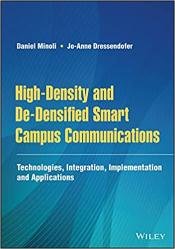 Название: High-Density and De-Densified Smart Campus Communications: Technologies, Integration, Implementation and Applications
Название: High-Density and De-Densified Smart Campus Communications: Technologies, Integration, Implementation and ApplicationsАвтор: Daniel Minoli, Jo-Anne Dressendofer
Издательство: Wiley
Год: 2022
Страниц: 366
Язык: английский
Формат: pdf (true)
Размер: 26.4 MB
Discover how to design, deliver, and implement high-density communications solutions.
High-Density Smart Campus Communications: Technologies, Integration, Implementation and Applications delivers a concise synthesis of the deployment technologies, strategies, and implementation issues that arise in the design and application of real-world high-density communications environments in airports, stadiums, convention centers, shopping malls, classrooms, hospitals, cruise ships, and more. You'll learn future-oriented strategies for the implementation of next-generation Wi-Fi and 5G communications networks in high density environments, like smart airposrts, advanced airport robotics, and wayfinding. You’ll also discover effective deployment strategies using a comprehensive case study based on a top-10 airport deployment by the Slice Wireless team.
The world has moved to IP for all data, voice, and video communications. Additionally, there is a trend toward the use of Wi-Fi-based hotspot communication in all practical situations, due to near ubiquity of service, lower end-user costs, higher bandwidth, technical simplicity, lower infrastructure costs, decentralized administration, regulation relief, and non-bureaucratic delivery of service (without the reliance of large institutional providers). While 5G promises to deliver a set of new capabilities, neither 3G nor 4G displaced Wi-Fi as a common access technology in the office, in the campus, on the street, and in travel. The technologies per se used for high-density communications are not new (perhaps with the exception of 5G), but the requirements, as well as the design and system synthesis, are relatively unique.
The book includes information about security requirements, large and boutique solution providers, applications, unbundled services, implementation planning and design, as well as operations and network management. An epilogue written by Josie Jo-Anne Dressendofer of Slice Wireless concludes the text. Readers will also benefit from the inclusion of:
A thorough introduction to background and functional requirements for high density communications, including requirements for airports, stadiums, convention centers, classrooms, train and subway stations, and smart cities
An exploration of traditional voice and cellular technology, including DAS designs and architectures and microcellularization
Practical discussions of traditional data and Wi-Fi, including throughput/interference and security
A treatment of evolved hotspot connectivity, including Wi-Fi and 5G
Perfect for telecommunication researchers and engineers, networking professionals, technology professionals, campus administrators, and equipment vendors, High-Density Smart Campus Communications will also earn a place in the libraries of senior undergraduate and graduate students in applied communications technologies.
Contents:
1. Background and Functional Requirements for High-Density Communications
2. Traditional WLAN Technologies
3. Traditional DAS Technologies
4. Traditional Sensor Networks/IoT Services
4.3 Wireless Technologies for the IoT
4.3.1 Pre-5G Wireless Technologies for the IoT
4.3.2 NB-IoT
4.3.3 LTE-M
4.3.4 5G Technologies for the IoT
4.3.5 WAN-Oriented IoT Connectivity Migration Strategies
4.4 Examples of Seven - Layer IoT Protocol Stacks
4.4.1 UPnP
4.4.2 ZigBee
4.4.3 Bluetooth
5. Evolved Campus Connectivity
6. De-densification of Spaces and Work Environments
7. UWB-Based De-densification of Spaces and Work Environments
8. RTLSs and Distance Tracking Using Wi-Fi, Bluetooth, and Cellular Technologies
9. Case Study of an Implementation and Rollout of a High-Density High-Impact Network
10. The Age of Wi-Fi and Rise of the Wireless SuperNetwork (WiSNET)TM
Index
Скачать High-Density and de-Densified Smart Campus Communications